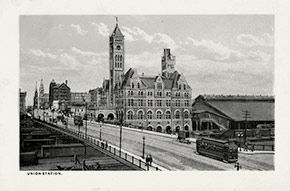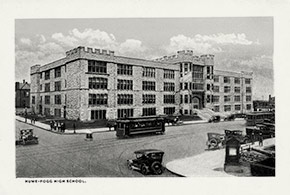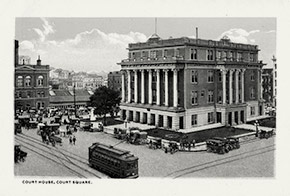Produced by the University of Michigan Center for the History of Medicine and Michigan Publishing, University of Michigan Library
Influenza Encyclopedia
The American Influenza Epidemic of 1918-1919:
A Digital Encyclopedia
Nashville, Tennessee
50 U.S. Cities & Their Stories
It was late-September 1918 when Nashville heath officials first caught wind that the influenza sweeping across the nation might be within their community as well. On September 27, local newspapers reported that there were at least a handful of cases within the city, but that authorities could not be certain since influenza was not a mandatory reportable disease in either Nashville or Tennessee. Two days later, city health officials as well as Captain Dr. Robert C. Derivaux, the local representative of the United States Public Health Service, reiterated that influenza was in Nashville. No cases had yet been confirmed officially – physicians had been diagnosing the cases as simply grip – but welfare department nurses reported being called to care for many victims.1 Dr. W. F. Fessey, Superintendent of City Hospital, reported that thirty cases of influenza had been admitted to his hospital and that 75 cases had to be turned away due to lack of space. Fessey predicted that, at this pace, Nashville would experience a serious outbreak within the next “five to six days.”2 It occurred even faster: within a day, City Hospital was almost completely full with influenza patients.3 Meanwhile, officials at the Old Hickory powder plant – a DuPont factory some ten miles to the northeast that produced smokeless powder for the war effort – vociferously denied that an epidemic of influenza had broken out among its 35,000 men workforce, despite admitting to many cases of grip at the plant. With the need for maximum wartime production, sick employees were separated from the well, but were still put to work.4 Nashville’s epidemic was off to a roaring start.
By October 5, Nashville Health Officer Dr. W. E. Hibbett estimated that there were between 10,000 and 15,000 influenza cases in the city. In order to get a better sense of the geographic spread of the disease, asses the needs of the state’s counties, and allocate nurses and other resources more efficiently, the Executive Officer of the State Board of Health, Dr. Olin West, requested that city and county health officers report local conditions directly to his office. He also notified all local agencies that requests for Red Cross aid must be made through the US Public Health Service, and that requests for Public Health Service assistance needed to be made through his office. In short, Olin placed himself at the head of Tennessee’s epidemic response. He urged local officials to consider school closures if absenteeism rates warranted it, and added that children in schools should be monitored closely for any and all signs of illness.5
On Sunday, October 6, Hibbett met with Olin, Derivaux, and several other public health officials to discuss Nashville’s rapidly growing epidemic. The next day, he announced the immediate closure of all theaters, movie houses, and other non-essential amusement venues. Schools and churches would remain open for the time being, although Hibbett was quick to add that he might extend the closure order to those institutions as well if conditions warranted. Mayor William Gupton fully endorsed Hibbett’s action, stating that he was in complete accord with the opinions of federal, state, and city health officers and would “lend them every assistance in his power.”6 In surrounding Davidson County, the Board of Education ordered all schools closed effective immediately. The decision came not as a result of high levels of influenza in county schools, but rather because of the long distances physicians were required to travel between patients. Tamping down on the county’s epidemic therefore would not only save lives, it would spare doctors precious time that they now found themselves needing rather desperately.7
Theater managers were reported to be “cheerfully acquiescent” as they closed their venues. There was no doubt, however, that the closure order would impact their businesses heavily. The order came right at the start of the busy season, when the city’s theaters made arrangements for special shows. Pool halls and other such places were also placed under financial duress. Rents and other expenses for these businesses were high, and even a short-duration closure placed them in jeopardy of having to close their doors permanently.8
On October 8, Olin issued a statewide request that local authorities close places of amusement and strongly consider closing their schools too. In Nashville, Hibbett immediately put the request into action and closed the city’s schools effective at noon the next day, giving education officials, teachers, and principals time to prepare for the closures.9 Hibbett asked that churches close as well, although he did not order them to do so. Immediately, clergy across the city voluntarily agreed to cancel all prayer meetings. At a subsequent meeting, the Ministers’ Alliance agreed to cancel regular church services.1 Nashville’s public gathering places were now effectively closed.
Within a week, it appeared as if the epidemic was waning. Reliable case tallies were not available, but Hibbett was optimistic based on the decreased number of calls to his office for help and because drugstores were reporting fewer requests for prescriptions. Hospitals reported fewer intakes.11 The health officer cautiously let on that the city’s closure orders might be removed soon of conditions continued to improve, and Deveraux agreed. October 21 saw no cases of influenza reported, the first such day since the start of the epidemic.12 Encouraged by the news, Hibbert, West, and Deveraux met two days later to consider removing the bans. Their decision: the local, regional, and national epidemic situations were improved enough to allow Nashville’s closure orders to be lifted on Sunday, November 3.13 Nashville’s affected businesses eagerly waited for that day.
Over the course of the next week, Nashville’s epidemic situation improved dramatically enough for Hibbett, Deveraux, and West to agree to rescind the closure order effective Friday, November 1, with schools reopening the following Monday.14 When they did, principals found attendance rates were back to normal. Education officials decided to modify the curriculum (dropping “informational” topics) and to shorten the Thanksgiving and Christmas breaks in order to make up for lost classroom time. Teachers were happy to learn that they would be paid for the period when schools were closed.15
On November 1, Derivaux filed a comprehensive report on Nashville’s epidemic with USPHS officials in Washington. According to him, Nashville experienced 40,000 influenza cases and 392 deaths during the epidemic, with an additional 10,000 cases and 267 deaths occurring at the Old Hickory powder plant. In Nashville, the first case appeared on September 16, with influenza becoming epidemic ten days later. It peaked between October 4 and October 7, and ended about October 20. Derivaux believed that conditions in Nashville had improved enough to allow him to sent two USPHS doctors back to St. Louis.16 Two weeks later, with only a handful of new influenza cases reported each day, Derivaux announced that Nashville could “close the book on the epidemic.” There would continue to be some cases, he reminded residents, “but they will so few and far between that they will not be deserving of exclusive scrutiny.”17
Nashville and the Old Hickory powder plant did see some cases and deaths over the rest of the fall and winter, but fortunately epidemic conditions did not return. By the end of February 1919, physicians reported that a total 875 epidemic-related deaths had occurred since September. The result was an excess death rate of 610 per 100,000, slightly higher than that of Birmingham (592) and significantly higher than of Louisville (406). In fact, Nashville’s epidemic was one of the most severe in the country.
Notes
1 “Think ‘Spanish Flu’ Has Appeared Here,” Nashville Banner, 27 Sept. 1918, 16; “Spanish Influenza Reported in City,” Nashville Tennessean, 29 Sept. 1918, 2.
2 “Scourge of Flu Closes Y. M. C. A. at Old Hickory,” Nashville Tennessean, September 30, 1918, p. 8
3 “Doctors to Confer on Local Epidemic,” Nashville Banner, 1 Oct. 1918, 7.
4 “Spanish ‘Flu” Hits Nashville” Nashville Banner, 29 Sept. 1918, 10.
5 “Nine Deaths from Spanish Influenza,” Nashville Banner, 5 Oct. 1918, 2; “Very Few Deaths from Spanish Influenza,” Nashville Banner, 6 Oct. 1918, 7
6 “Theaters Closed by Authorities,” Nashville Banner, 7 Oct. 1918, 8.
7 “Schools of County Closed,” Nashville Banner, 8 Oct. 1918, 8; “County Schools are Closed to Curb Influenza,” Nashville Tennessean, 8 Oct. 1918, 1.
8 “Theaters Closed by Authorities,” Nashville Banner, 7 Oct. 1918, 8; “Amusement Places Closed,” Nashville Tennessean, 8 Oct. 1918, 6; “County Schools are Closed to Curb Influenza,” Nashville Tennessean, 8 Oct. 1918, 1.
9 “City Schools Close on Account of Epidemic,” Nashville Tennessean, 9 Oct. 1918, 4.
10 “No Prayer Meetings Because of Epidemic,” Nashville Banner, 9 Oct. 1918, 2; “Churches Close on Account of Flu,” Nashville Tennessean, 11 Oct. 1918, 8.
11 “New Grip Case on the Increase,” Nashville Banner, 15 Oct. 1918, 3; “’Flu’ Situation Greatly Improved,” Nashville Banner, 16 Oct. 1918, 10.
12 “No New Cases of Influenza Reported,” Nashville Tennessean, 22 Oct. 1918, 4.
13 “Sunday Week is Date Designated for Lifting Lid,” Nashville Tennessean, 24 Oct. 1918, 11.
14 “Flu Ban to Be Lifted on Friday,” Nashville Banner, 29 Oct. 1918, 1.
15 “Board Favors Short Holiday,” Nashville Banner, 5 Nov. 1918, 2.
16 “Deaths from Flu in County Number 659,” Nashville Tennessean, 1 Nov. 1918, 13.
17 “Will Close Books on ‘Flu’ Tomorrow,” Nashville Banner, 14 Nov. 1918, 2.








